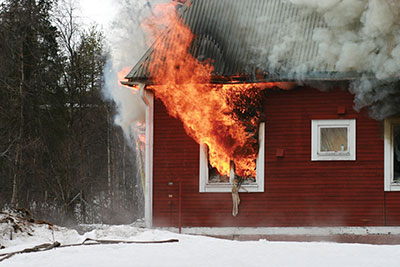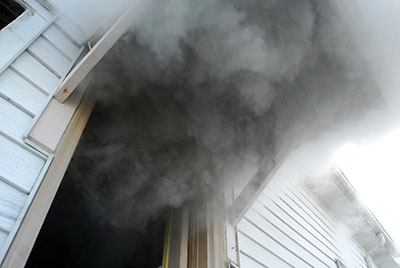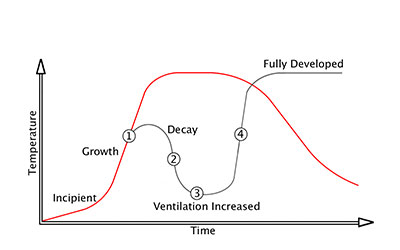
Features
Structural
Training
Understanding fire behaviour
The true impact of oxygen on fire growth and spread has long been understood by fire engineers.
February 10, 2014
By Ian Bolton
The true impact of oxygen on fire growth and spread has long been understood by fire engineers. For decades, these engineers have known that when a fire develops in a room or structure, the fire will burn within one of two burning regimes; these two burning regimes are often referred to as fuel-limited or fuel-controlled, and ventilation-limited or ventilation-controlled. This important concept has only recently begun to find its way into fire-service vocabulary, training and operational considerations, primarily because there has been a disconnect between the fire service and the research that can help it evolve.
 |
|
| Flames exiting a window are an indication that the fire is creating more ignitable gas-phase fuel than can be burned with available oxygen within the fire area and that it is ventilation-limited. Here, the fire gases leave the fire compartment and mix with the required air in order to burn.
|
Most firefighters are well aware of the fire-development curve represented by the red line on the graphic on page 48. Because this model is commonly introduced during basic firefighter recruit training, it is likely that it still represents most firefighters’ understanding of the way fires develop today.
Unfortunately, this curve depicts a fuel-limited fire that more accurately reflects the fire stages of a couch burning in an open parking lot; it is not a fair representation of how fires develop when confined in structures. Fundamentally, fuel-limited fires are those in which the heat-release rate (the amount of energy released over time) of the fire is limited primarily by the chemical and physical characteristics of the available fuels. In most structure fires, it is only during incipient and early growth stages that fuel is the limiting factor in the development and spread of the fire.
 |
|
| At a doorway, the existence of a mid-level neutral plane with air being drawn into the structure at a considerable velocity is a strong indicator that the fire is in need of more air to burn optimally and is ventilation-limited. |
During these early stages of fire development, fires often begin to become less affected by the characteristics of the available fuel and more affected by the limited air available within the fire compartment and the structure (see position 1 on graph). When this occurs, the fire’s growth is largely dictated by ventilation. It is at this time that the fire is said to have transitioned to ventilation-limited from fuel-limited.
“Ventilation-limited fires are more typical of the fires you are going to encounter on the streets today,” said Dan Madrzykowski, a fire-protection engineer in the fire research group of National Institute of Standards and Technology (NIST), in a presentation to firefighters at the 2013 IAFF Redmonds Symposium on occupational health and safety. Fires burning within this state will be drastically affected by any increase in ventilation to the fire. It should also be noted that ventilation within a building is always occurring: lack of ventilation does not mean lack of tactical ventilation performed by firefighters, but refers solely to the lack of air available for the developing fire.
In 1917, British scientist William Thornton discovered that the consumption of oxygen by a fire is directly related to the amount of energy created. Furthermore, it was found that regardless of what product may be burning, whether it is a piece of wood or a polyurethane sofa, for each kilogram of oxygen used for combustion, approximately 13.1 megajoules of heat energy is created. This concept allows us to make some basic calculations to determine how long it will take for any given room or structure to run out of the oxygen required for a fire to continue to develop. In a large living space measuring 2.5 metres by 6 metres by 12 metres in area, with a fire burning at a steady state of two megawatts, the oxygen would be depleted in about five minutes and 24 seconds if all windows and door were closed. This is, however, a considerable oversimplification, as fires begin to burn at a lower heat-release rate and grow until they are limited by oxygen, and as levels often fall below the 15 per cent required for fires to burn efficiently. Furthermore, there is often leakage through doors and windows that allows for some smoke and air exchange. Regardless, the impact of oxygen and the critical impact it has on fire production of thermal energy has long been misunderstood or somewhat dismissed by many firefighters.
■ Today’s ventilation-limited timeline
The highly combustible fuel loads found in homes today have changed the rate at which fires transition to ventilation-limited from fuel-limited. Underwriters Laboratories Firefighter Safety Research Institute (ULFSRI) has compared the difference in the time it takes for fire to become ventilation-limited in a home with older furniture made of natural products circa 1970s, and another home filled with modern, synthetic-based furniture. The results were staggering. The natural-material based furniture, referred to as legacy furnishings, reach ventilation-limited conditions 20 minutes after ignition. The modern fire reached ventilation-limited conditions in just five minutes. Furthermore, when tactical ventilation tactics were introduced – opening the front door and removing a window – the time in which the two fires flashed over and reached the fully developed stage was also alarming: while fire in the legacy unit took eight minutes and 30 seconds to reach flashover, the fire in the modern setting did so in just two minutes and 15 seconds, demonstrating how much more quickly today’s fires react to oxygen.
NIST and ULFSRI tests have also shown that once a fire runs out of oxygen and becomes ventilation-limited, temperatures inside the structure start to decline rapidly (see position 2 on graph) as the fire is in the decay stage and can no longer release sufficient thermal energy. When this occurs, the existing hot fire gases begin to contract in volume, which often results in the structure entering a state of negative pressure. Subsequently, previously visible smoke that may have been exiting from windows or other areas will stop, and the negative pressure created by the contracting fire gases will result in air being drawn into the structure via any available ventilation openings or gaps. Fire crews arriving on scene at this time may see no smoke showing, even though the structure is charged with hot, ignitable smoke.

|
|
| This red line represents the fire-development curve of a fuel-limited fire, such as a couch burning in an open parking lot. Unfortunately, this model does not accurately represent how fires develop in confined structures.
|
It is common for crews to arrive on scene after a fire has transitioned into the ventilation-limited state. Even if a fire has self-vented and flames are showing out a window, it is highly likely the fire is still ventilation-limited. In these cases, flames are burning outside the fire compartment because there is not sufficient air inside to allow the fire gases to burn. Furthermore, the rest of the structure may also be full of hot fire gases that are unable to burn due to lack of oxygen. At this point, crews need to recognize the potential impact any further supply of air will have on the fire. As fire behaviour expert Chief Ed Hartin explains, “If a developing compartment fire becomes ventilation-controlled [limited] with the heat release rate limited by the oxygen available in the compartment, any increased ventilation at this point (see position 3 on graph), may cause the fire to quickly transition to the fully developed stage.” (See position 4 on graph.)
(For videos of ULFSRI and NIST test demonstrating these concepts, visit vimeo.com/80730910 )
■ Recognizing the danger
In order for fire crews to make appropriate decisions on the fire ground, the prevailing fire condition must be recognized and understood. Identifying a fire that is ventilation-limited is critical to safe and effective operations.
Some common signs and indicators of a fuel-limited fire are:
- An incipient or early growth fire
- High neutral plane (smoke layer)
- Better visibility
- Relatively low temperatures
Some common signs and indicators of a ventilation-limited fire are:
- Fire is beyond incipient stage
- Mid to low neutral plane (smoke layer)
- Poor visibility
- Flames exiting outside a window or door
- Air being drawn into the fire when a door is opened
- Increased temperatures, but will be declining if in decay stage
- All common backdraft indicators
■ Tactical considerations
Assumptions are generally bad. If crews assume a fire is fuel-limited upon arrival and makes inappropriate decisions, potentially negative results may occur. Assuming every working fire is ventilation-limited upon arrival is likely correct and will also improve firefighter safety as members will control available air to the fire until it will serve as a tactical advantage to do otherwise.
If no smoke is issuing from a structure upon arrival, the fire may be ventilation-limited and in decay stage as the structure is in a state negative pressure. For this reason, nothing showing upon arrival . . . means nothing! A proper size-up is necessary to determine whether or not crews have a working fire.
The front door must be considered as ventilation. Doors provide access for fire crews to perform fire attack and search, but opening a door also allows fresh air in to feed a developing fire. Closing an open door to a house immediately upon arrival – until there is a tactical advantage to opening it – will help to control the heat-release rate of the fire. As well, in some situations, firefighters may want to consider door-control tactics while a fire crew advances a line in search of the fire.
For further information about ventilation-limited fires, and the impact of oxygen on fire conditions, visit ulfirefightersafety.com and view the various ULFSRI reports on horizontal and vertical ventilation.
Ian Bolton has been a student of the fire service for more than a decade. While working in Sydney, Australia, he was trained as a fire behaviour and tactical ventilation instructor and has received additional training in these areas through the Swedish Civil Contingency Agency in Revinge, Sweden. Currently, Ian is a firefighter and the lead fire behaviour instructor for the District of North Vancouver Fire Rescue Service. Ian also serves on a technical panel at Underwriters Laboratories Firefighter Safety Research Institute and is pursuing a fire science degree from Western Oregon University in Monmouth, Ore. Contact Ian at ian.bolton@firedynamics.ca
Print this page